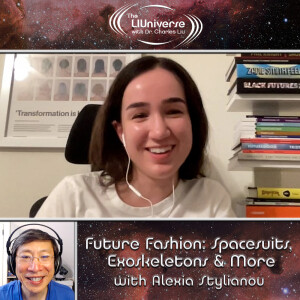
Saturday Mar 22, 2025
Future Fashion: Spacesuits, Exoskeletons & More with Alexia Stylianou
What will well-dressed astronauts be wearing on the Artemis III mission? Will AI destroy creativity? Can we actually make leather clothing out of mushrooms?
To find out, Dr. Charles Liu and co-host Allen Liu welcome engineer and futurist Alexia Stylianou, who is designing wearable biometric platforms that can measure human biomechanics to a resolution and degree far beyond what’s accessible to everyday people.
Before we get to introducing our guest this episode, though, Charles whets our appetite about amazing developments coming out of the Vera C. Rubin Observatory where he’s on the Science Advisory Committee.
Our joyfully cool cosmic thing of the day is Firefly Aerospace’s Blue Ghost Mission 1 to the Moon. As Allen points out, it’s part of NASA’s CLPS (Commercial Lunar Payload Services) initiative and is the most successful private Lunar landing to date – among other things, it landed right-side up! Alexa talks about the importance of giving engineers the freedom to solve problems and the uncertainty of programs like this continuing to be funded by NASA. Allen brings up the Viper, a NASA-funded lunar rover which was built, but lost its funding before testing was completed.
Charles asks Alexia to tell us about an example of something on the horizon she thinks is really cool, and she mentions that Prada is designing the space suits for the Artemis III mission in partnership with Axiom Space. She explains that Prada has a history of using cutting edge materials and design that makes them an appropriate partner in the process.
Then it’s time for our first audience question. Luis asks, “What is needed to create the next amazing space technology that will break all the conventions we have about space travel?” Alexia talks about the increasing importance of incorporating user-centered design or human-centered design, and how it’s revolutionizing the process. You’ll hear about the development of direct pressure space suits, as well as research into exoskeletons for use in industry and auto manufacturing – although sadly, Alien-style exoskeleton loaders like Ripley uses are still science fiction, for now.
Looking even further out, Alexia talks about nuclear semiotics – the effort to come up with ways to communicate to societies that will exist hundreds of thousands of years in the future the danger of radioactive material we’re creating now? You’ll find out why the skulls and crossbones and other danger iconography we use now aren’t up to the task, and the universality of stick-figure iconography.
Our next question comes from Johanna: “Will AI destroy creativity?” Questions like this are becoming more frequent, especially in areas like education. Chuck, Alexia and Allen jump into a thought-provoking conversation, and how there are ways to let students use AI as a tool like a calculator while simultaneously incentivizing and stimulating their creativity.
Speaking of creativity, Chuck asks Alexia about her love of science fiction and the well-designed stack of books behind her (sorry, Podcast People!). She pulls out and describes “Gideon the Ninth,” the first book in a sci-fi fantasy series about immortal space necromancers by Tamsyn Muir. Alexia talks about speculative fiction and speculative design, and tells us about a team of designers that have created a room that smells like the pollution of the future in order to offer a tangible way to engage our senses now about a future we might yet be able to avoid.
Finally, Chuck asks Alexia for one more cool futuristic development she’s wants us all to think about. She tells us about the development of mushroom leather (aka mycelium leather), an alternative, eco-friendly, and ethical textile made from fungi grown on apple waste.
If you’d like to know more about Alexia, you can find her on LinkedIn.
We hope you enjoy this episode of The LIUniverse, and, if you do, please support us on Patreon.
Credits for Images Used in this Episode:
- NSF-DOE Vera C. Rubin Observatory on Cerro Pachón in Chile. – Credit: NSF-DOE Rubin Observatory/AURA/B. Quint.
- Blue Ghost final descent and landing video. – Credit: NASA/Olivia Tyrrell.
- Prada and Axiom Space Extravehicular Mobility Unit (AxEMU). – Credit: Prada/Axiom Space (image provided for press coverage).
- The Space Activity Suit developed by Paul Webb and built under a NASA project (taken c. 1971). – Credit: NASA.
- Exoskeleton designed for the auto industry by Ekso Bionics. – Credit: Ekso Bionics.
- Proposed design for "small subsurface markers" to be buried randomly in great numbers across the Waste Isolation Pilot Plant. – Credit: Department of Energy (Public Domain).
No comments yet. Be the first to say something!